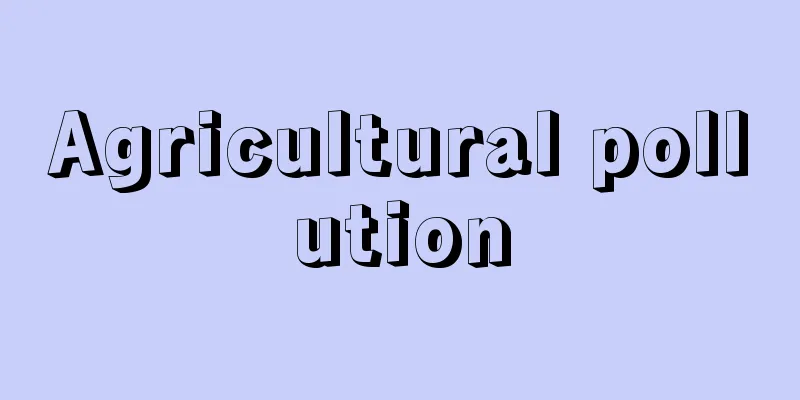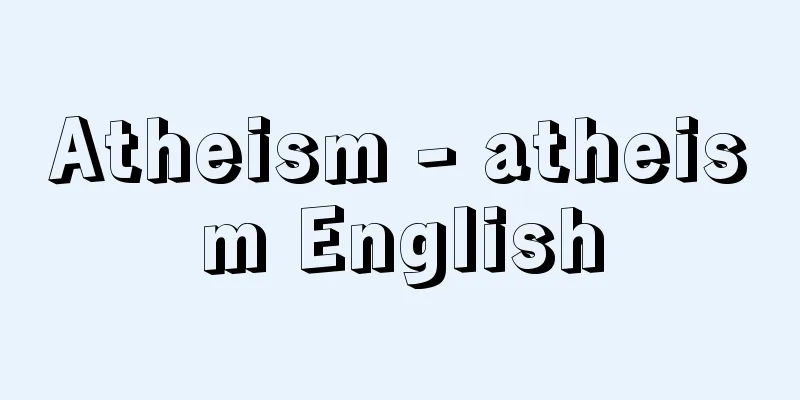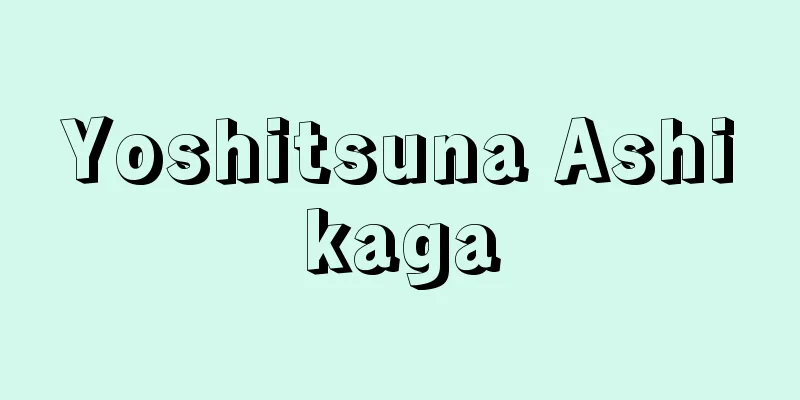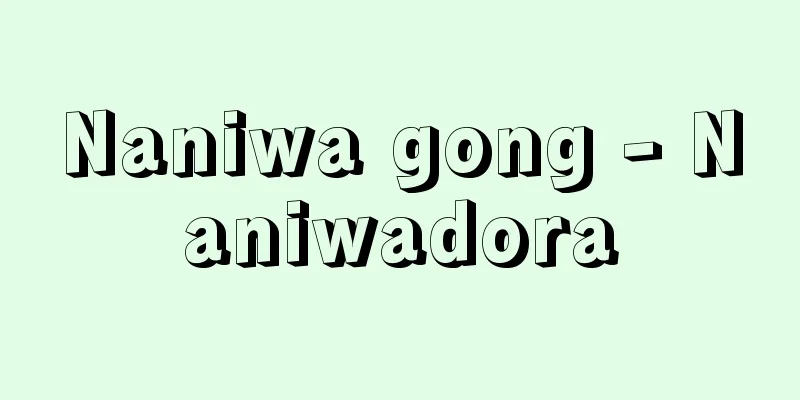Agricultural pollution

|
This refers to environmental pollution that occurs during the production and processing of agricultural products. It includes not only pollution caused by the spraying of pesticides and chemical fertilizers during the production stage, but also pollution caused during food processing and retail, and pollution caused by wastewater from agricultural producers' daily lives. That is to say, the agricultural pollution phenomena that are becoming a problem in Japan include contamination of crops and livestock, the entire ecosystem, and even the human body, through the use of pesticides, contamination of soil and water quality through the excessive use of chemical fertilizers, contamination through the disposal of agricultural materials such as vinyl for greenhouse horticulture, livestock pollution through livestock manure, contamination through waste from the food processing industry, etc. Of these, the use of pesticides and additives is particularly serious, and the inclusion of large amounts of these in food directly threatens human health and life. Among agricultural pollution, pesticide pollution has progressed significantly. Famous insecticides in the history of pesticides are DDT (created in 1938) and BHC (created in 1943), but they only began to be used as pesticides in the 1950s. At the time, they were believed to be harmless to humans and animals, and DDT was even sprayed over people's entire bodies, from the head to the head, to get rid of lice and fleas. In addition, the organic mercury agent Ceresan was used in large quantities to control rice blast disease, and the use of organophosphate agents Parathion and Malathafina to exterminate rice leafminers also increased sharply. The use of such pesticides caused cases of pesticide poisoning all over the country, and as pollution-related diseases such as Itai-itai disease, caused by cadmium, and Minamata disease, caused by organic mercury, became social problems, the harmfulness of mercury and organophosphate pesticides was examined, and in 1971 the Agricultural Chemicals Control Law was fundamentally revised, and the use of DDT, BHC, 245T, and organophosphate pesticides was banned. During Japan's period of rapid economic growth, the amount of pesticides used was second only to Israel, and was seven times that of the United States. The use of organochlorine herbicides increased from the 1970s onwards, and the dangers of dioxin were pointed out both domestically and internationally in the 1980s. Residual dioxins have been detected over a wide area of Japanese rice paddy soil, and contamination of rice and other agricultural crops has become evident especially since the late 1990s. In 1999, the Basic Agricultural Law was revised and the new "Basic Law for Food, Agriculture and Rural Areas" came into force, and a policy was launched aiming at the sustainable development of agriculture by maintaining and enhancing the natural circulation function. This policy promotes the proper use of pesticides and chemical fertilizers. Specifically, these are the three agricultural environment laws: "Law on Promoting the Proper Management and Utilization of Livestock Excreta," "Law on Promoting the Introduction of Highly Sustainable Agricultural Production Methods," and "Fertilizer Control Law." The key to combating agricultural pollution as described above is to establish and spread a production technology system that minimizes the use of pesticides at the production and processing stages of agricultural produce. In other words, this means working with consumers to realize organic farming without pesticides or chemical fertilizers, or IP farming (integrated production method) with reduced use of pesticides and chemical fertilizers, through a direct sales system. [Yoichi Matsuki] "Silent Spring: The Elixir of Life and Death, by R. Carson, translated by Aoki Yanichi (Shincho Bunko)" ▽ "Environmental Pollution and Agriculture, by Ogata Tamotsu et al. (1975, Hakuyusha)" ▽ "Pesticides Are Also Additives, by Fukushima Yoichi (1984, Mebaesha)" ▽ "Environmental Conservation and the Partnership Between Agriculture, Forestry, Fisheries, and Consumers, edited by the National Federation of Agricultural Cooperative Associations (1999, Ie no Hikari Kyokai)" ▽ "The Pesticide Situation in Japan, by Kono Shuuichirou (Iwanami Shinsho)" [Reference items] | | | | | | | | | |Source: Shogakukan Encyclopedia Nipponica About Encyclopedia Nipponica Information | Legend |
|
農産物の生産および加工に伴って発生する環境汚染をいう。生産段階で農薬や化学肥料などを散布することによって生じる場合のみならず、食料品の加工、小売段階で生じる場合、農業生産者の生活汚水などによる場合などが含まれる。 すなわちわが国で問題になっている農業公害現象は、農薬使用による作物・家畜、生態系全体ひいては人体への汚染、化学肥料の多投による土壌・水質の汚染、ハウス園芸用のビニルなどの農業資材の廃棄による汚染、家畜糞尿(ふんにょう)などによる畜産公害、食品加工業の廃棄物による汚染、などである。このうちとくに、農薬や添加物の使用がもっとも重大なものであり、これらが食品に多量に含まれることにより、人間の健康と生命が直接脅かされている。 農業公害のなかでも農薬汚染の進行が著しい。農薬の歴史で有名な殺虫剤にDDT(1938創製)やBHC(1943創製)があるが、これらが実際に農薬として使用され始めたのは1950年代である。当時は人畜無害と信じられ、DDTなどは人にもシラミやノミの駆除のために頭から全身散布したほどであった。また、イネのいもち病の防除のために有機水銀剤であるセレサンが多投され、あわせてメイチュウの駆除に有機燐(りん)剤のパラチオンやマラソンの使用が急増した。 このような農薬使用によって全国各地で農薬中毒が発生し、またカドミウムが原因のイタイイタイ病や有機水銀が原因の水俣(みなまた)病などの公害病が社会問題化するにつれ、水銀剤と有機燐剤の有害性が検討され、1971年(昭和46)に農薬取締法の抜本的改正がなされて、DDT、BHC、245Tおよび有機燐剤の使用禁止が決定された。 日本の高度経済成長期の農薬使用量はイスラエルに次ぎ、アメリカの7倍にも達していた。1970年以降は有機塩素剤の除草剤の使用が増加し、80年代にはダイオキシンの危険性が国内的にも国際的にも指摘された。日本の水田土壌の広範囲にわたって残留ダイオキシンが検出されており、とくに90年代後半以降、米や農作物への汚染が顕在化している。 1999年(平成11)に農業基本法が改正されて新しい「食料・農業・農村基本法」が施行され、自然循環機能の維持増進によって農業の持続的発展を目ざす政策が開始された。それは農薬、化学肥料の適正使用を推進するものである。具体的には、農業環境三法といわれる「家畜排せつ物の管理の適正化及び利用の促進に関する法律」「持続性の高い農業生産方式の導入の促進に関する法律」「肥料取締法」である。 以上のような農業公害に対する対策にとって重要なことは、農産物の生産加工段階での農薬使用を最小限にしていく生産技術体系の確立と普及が不可欠である。すなわち、無農薬・無化学肥料の有機農法や減農薬・減化学肥料のIP農法(統合的生産方法)を消費者と提携し、産直方式によって実現していくことである。 [松木洋一] 『R・カーソン著、青樹簗一訳『沈黙の春――生と死の妙薬』(新潮文庫)』▽『尾形保他著『環境汚染と農業』(1975・博友社)』▽『福島要一著『農薬も添加物のひとつ』(1984・芽ばえ社)』▽『全国農業協同組合連合会編『環境保全と農・林・漁・消の提携』(1999・家の光協会)』▽『河野修一郎著『日本農薬事情』(岩波新書)』 [参照項目] | | | | | | | | | |出典 小学館 日本大百科全書(ニッポニカ)日本大百科全書(ニッポニカ)について 情報 | 凡例 |
<<: Agricultural engineering - agricultural engineering
>>: Agricultural Research Center
Recommend
Cimmerian
An Iranian ethnic group that first formed a horse-...
Dai Nam Quoc Su Dien Ca (Dai Nankokushi Enka)
This is a poem in the Vietnamese national language...
Norodom Sihanouk
Cambodian royal politician. He ascended to the th...
Monotype
A type of automatic typecasting machine. Invented ...
Xylotrechus chinensis (English spelling) Xylotrechuschinensis
...Many of them fly to flowers and eat pollen. Th...
Business Management Outlook
...The DI created in the same way for all 30 indi...
Price competitiveness
...In a broader sense, it can also be used to ref...
Oga [city] - Oga
A city in the western part of Akita Prefecture, co...
Ashurian stone tools
...After about 1.5 million years ago, a more soph...
Kushan Gold Coin
…Roman imperial documents tell us that a large am...
Shingles - Herpes zoster
What kind of infection is it? A band-like blister...
Social Problems Research Society
(1) It was founded in the winter of 1892 by Yusaku...
Antoine Theatre
…Although he took naturalism too far, such as han...
Valdemar I
1131‐82 King of Denmark. Reigned 1157-82. Also kno...
Brooklyn [District] - Brooklyn
One of the five boroughs of New York City, USA. It...









